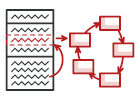
State を C++ で
State は、 振る舞いに関するデザインパターンの一つで、 オブジェクトの内部状態が変化した時にその振る舞いを変更することを可能とします。
このパターンは、 状態に関連した振る舞いを個別の状態のクラスへ抽出し、 元のオブジェクトが作業を自分で行わず、 これらのクラスのインスタンスに委任することを強制します。
複雑度:
人気度:
使用例: C++ では、 State パターンは、 膨大な数の switch 文に基づく状態機械をオブジェクトに変換する時によく使われます。
見つけ方: オブジェクトが、 その外的に制御される状態によって振る舞いを変えるようなメソッドを持っていたら、 State パターンを識別できます。
概念的な例
この例は、 State デザインパターンの構造を説明するためのものです。 以下の質問に答えることを目的としています:
- どういうクラスからできているか?
- それぞれのクラスの役割は?
- パターンの要素同士はどう関係しているのか?
main.cc: 概念的な例
#include <iostream>
#include <typeinfo>
/**
* The base State class declares methods that all Concrete State should
* implement and also provides a backreference to the Context object, associated
* with the State. This backreference can be used by States to transition the
* Context to another State.
*/
class Context;
class State {
/**
* @var Context
*/
protected:
Context *context_;
public:
virtual ~State() {
}
void set_context(Context *context) {
this->context_ = context;
}
virtual void Handle1() = 0;
virtual void Handle2() = 0;
};
/**
* The Context defines the interface of interest to clients. It also maintains a
* reference to an instance of a State subclass, which represents the current
* state of the Context.
*/
class Context {
/**
* @var State A reference to the current state of the Context.
*/
private:
State *state_;
public:
Context(State *state) : state_(nullptr) {
this->TransitionTo(state);
}
~Context() {
delete state_;
}
/**
* The Context allows changing the State object at runtime.
*/
void TransitionTo(State *state) {
std::cout << "Context: Transition to " << typeid(*state).name() << ".\n";
if (this->state_ != nullptr)
delete this->state_;
this->state_ = state;
this->state_->set_context(this);
}
/**
* The Context delegates part of its behavior to the current State object.
*/
void Request1() {
this->state_->Handle1();
}
void Request2() {
this->state_->Handle2();
}
};
/**
* Concrete States implement various behaviors, associated with a state of the
* Context.
*/
class ConcreteStateA : public State {
public:
void Handle1() override;
void Handle2() override {
std::cout << "ConcreteStateA handles request2.\n";
}
};
class ConcreteStateB : public State {
public:
void Handle1() override {
std::cout << "ConcreteStateB handles request1.\n";
}
void Handle2() override {
std::cout << "ConcreteStateB handles request2.\n";
std::cout << "ConcreteStateB wants to change the state of the context.\n";
this->context_->TransitionTo(new ConcreteStateA);
}
};
void ConcreteStateA::Handle1() {
{
std::cout << "ConcreteStateA handles request1.\n";
std::cout << "ConcreteStateA wants to change the state of the context.\n";
this->context_->TransitionTo(new ConcreteStateB);
}
}
/**
* The client code.
*/
void ClientCode() {
Context *context = new Context(new ConcreteStateA);
context->Request1();
context->Request2();
delete context;
}
int main() {
ClientCode();
return 0;
}
Output.txt: 実行結果
Context: Transition to 14ConcreteStateA.
ConcreteStateA handles request1.
ConcreteStateA wants to change the state of the context.
Context: Transition to 14ConcreteStateB.
ConcreteStateB handles request2.
ConcreteStateB wants to change the state of the context.
Context: Transition to 14ConcreteStateA.